EYE-WITNESS ACCOUNTS OF THE BEGINNINGS OF PANEURHYTHMY:
from hitherto unpublished original manuscripts typed or dictated by the author,
and faithfully translated into English without alteration.
|
|
BORIS NIKOLOV: |
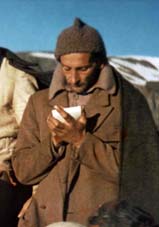 |
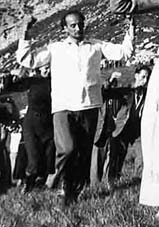 |
|
|
( Reminiscences of Boris Nikolov who was one of the closest disciples and helpers of Peter Deunov and died
in 1991. Excerpts from one of his annual letters to the Brotherhood on the First Day of Spring. ):
The sun is the emblem of the Brotherhood of Light. The sun is the source of life. The Master
used to start his work by meeting the Sunrise. He used to sanctify the morning hours with meditation,
contemplation and prayer, and he always recommended being out of doors early in the morning. In this way
he attracted those who sought this way of life and set the foundations for the Brotherhood. Later the
Master also expressed his inner aspiration through songs and exercises.
I remember how PanEuRhythmy was first created. The Master worked naturally and simply, but never
missed a moment of inspiration. He used to pay attention to each inner impulse. One late
afternoon in Spring the Master and some brothers and sisters were in the meadow near some pine trees,
talking about folk circle dances and folk songs. Some of the people present started demonstrating
some steps from folk dances. The Master sang a little melody and said, "With what kind of movement
could you express this melody?"
Some of those present started experimenting with steps and movements to express the melody, but without
success. Then the Master demonstrated some graceful, natural and rhythmical movements, which
obviously corresponded with the melody. In this way the first movement of PanEuRhythmy was
born. At the time it seemed like a chance event, but this provided the impetus for the work to
begin. The Master took the idea, went to his room and started working. The exercises were
then born one after another.
The creative power had been kindled and grew stronger and stronger. The Master became deeply involved
in this work, and at night we would often hear the violin playing in his room. In the morning he would
try out the new exercises with his disciples. They would learn the melodies, the steps and the
movements, as the Master corrected, elaborated and clarified. He was focused and inspired and his
face would glow with an inner fire. With what love the Master worked and with what
enthusiasm! Afterwards he would return to his room for a long time, seeking with his violin to find
and express the melody, the movement, the steps and the rhythms of PanEuRhythmy.
In this way a Sublime World was made manifest among us. The Master brought down the life of that
Sublime World, clothed it in forms and gave it expression in music and movement.
Several years ago a German professor and choreographer came to Izgrev. He had been traveling all
over the world researching national dances. Some journalists jokingly told him that in the early
mornings there were people dancing at the edge of the forest. The professor wanted to see these
people, and he came early one Sunday morning in the Spring. The apple trees were in blossom and the
snow glistened on Mt. Vitosha. At Izgrev the atmosphere was pure and light. The fragrance of the
apple and pine trees was everywhere. In the meadow two or three hundred people were
dancing. The professor was amazed, for this was the first time he had encountered the life of the
Brotherhood. The professor made choreographic notes, observing with keen interest the exercises,
the rhythm and the movements. This was a language he understood! After PanEuRhythmy, he
was introduced to the Master, and said to him, "I have been travelling all over the world, researching national
dances, but I have never found more simple and perfect movements than yours."
The songs and dances are a manifestation of a Higher and more Sublime Life, which the Master has made accessible
for us. The Master composed more than one hundred and twenty songs -- a great musical creation with
exceptional beauty, depth and power. These awaken the power of the soul, supporting her in her difficult
journey on earth, reminding her of her far-distant native country and showing her the way back to this
land. The whole creation of the Master, his word, his songs and his dances, are filled with
the power of the Sun. They are an expression of that Sublime World from which the Master came.
|
|
MILKA PEREKLIEVA:
( Another account of the beginnings of PanEuRhythmy (very similar to that by Boris Nikolov above) can be found
in the book, Memories Preserved In Time, by Professor Aleksander Perekliev Georgiev, who then goes on to
give the following account from his sister, Milka Pereklieva, author of that delightful book, Reminiscences
of the Master. ):
|
|
This is what my sister told me about her conversations with the Master in connection with PanEuRhythmy:
Milka Pereklieva once said to the Master, "How about printing a description of the PanEuRhythmy
exercises? People would appreciate a description of the movements along with the music and lyrics."
The Master replied, "Would you be able to describe the movements accurately and precisely?"
Milka answered, "I will try. I think I could. I would very much like to do this work."
The Master answered, "Then do it and tell me when you have finished."
"Every day," Milka continued her story, "I went to PanEuRhythmy and described one exercise in
detail. In order not to make mistakes, I did not dance, but sat behind a bush describing the exercise
and making notes which I carefully put in order at home afterwards. I revised each exercise several
times, corrected it, until I was sure that it was accurate, clear, precise and concise.
When all the PanEuRhythmy exercises had been described, I brought
the whole folder with the manuscripts to the Master. He seemed satisfied and asked me to read the
descriptions to him. He listened to me attentively. When I had finished reading, the Master
gave his approval to what I had written and praised me.
Then he said, 'It would be good for Boyan Boev to see this. Tell him what you have done and let him
see the manuscript.'
I went to Boyan Boev and told him what I was bringing him. He was delighted, took the text from
my hands and started reading it.
He said, 'Let me read while you do the exercises. In that way we shall see if the text corresponds to
the way we dance the exercises.'
So this is what we did. Boyan Boev read the descriptions out loud while I performed the movements.
'Perfect!' Boyan Boev said with great joy, when we had finished. Then we edited the text and added
in missing details and corrected any mistakes ...
Boyan Boev then said, 'Now take the text and check it several times more. Tolstoy revised his
book War and Peace four times. Then when it is ready, bring it back for me to print.'
Boyan Boev printed the text. I do not know how it was published, but I will not forget the
day when the Master called me and handed me the book with the description of the PanEuRhythmy movements.
'This is work for God,' said the Master, 'the PanEuRhythmy will not be forgotten now.' "
|
|
|
Professor Aleksander Perekliev Georgiev then goes on to describe how in 1943 his sister, Milka Pereklieva,
who was a school teacher, was invited by the Secretary of the Ministry of Education to prepare a protocol
for teaching PanEuRhythmy in the schools. She consulted the Master, who confirmed that this was
a very important work for the future of the nation. Milka then drew up a document which was
officially accepted, and soon afterwards, she and Vessela Nestorova started teaching PanEuRhythmy to the
schoolteachers, so that they could then instruct their pupils. They continued this work together
until December 1943, when the first bombs were dropped on Sofia.
|
|
ELENA ANDREEVA: |
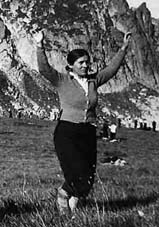 |
|
|
( From Reminiscences by Elena Andreeva of Life With The Master. Elena came to the Master in 1920
and became one of his stenographers. ):
My attention was always drawn to the way the Master walked, and I loved seeing how lightly he
stepped. There was something special about the way he walked. His body was absolutely
straight, his head and spine in a straight line. He would walk briskly and purposefully, and one
was scarcely aware of the weight of his body passing smoothly from one leg to the other. There was no
swinging from side to side. His body moved straight forwards. His steps were neither short
nor long, but in harmonic proportion with his whole body. That is why I so much enjoyed watching the
Master walk. There was freedom in his movements and no stiffness to bring disarmony in his arms,
legs, head or body. Everything came together and made a very good impression. He walked
briskly and he stepped lightly. He held his head straight and his hair would swing like
wings. I was impressed by his purposeful forwards movement. His movements were free, light,
natural, graceful and beautiful ...
When the Master taught us PanEuRhythmy exercises, we would notice the beauty of his movements. When he
lifted his arm upwards or down, forwards or back, each movement was free and devoid of tension, but never
limp. His movements were full of swing, beauty, lightness and grace. They were so beautiful
that we were filled with rapturous admiration. This exquisite beauty in his movements I noticed mainly
when the Master was demonstrating new PanEuRhythmy exercises. When we danced PanEuRhythmy together
with him, he danced accurately and well, but I only noticed this exquisite beauty when he was demonstrating
new exercises. When the Master expressed such beauty, we were very inspired and tried to imitate him,
but there were very few who could succeed. When I observed the others, I saw that no one was able to
do the movements as well as he. Some people were not even able to do the movements accurately or beautifully.
I am sorry to say that very few of our friends were able to observe the teaching of the PanEuRhythmy
exercises by the Master himself. This seemed to happen according to some inner mood or rhythm
within him. Usually after the Master demonstrated new exercises, he would not repeat the demonstration,
and would encourage us to study from those who had learnt from him personally. It was very rare for him
to repeat any of the demonstrations.
Katya Griva* said that, when the Master demonstrated new exercises to her and she danced after him, he danced
with exquisite and magnificent beauty and harmony, and for her it was extremely difficult to imitate him
precisely. When he danced outside with the others it was not the same.
|
* Katya Griva was one of the original few 'sisters' to whom the Master demonstrated the exercises
personally and entrusted with teaching them to the others. She first came to the Master in 1932.
|
|
|
MARIA ZLATEVA: |
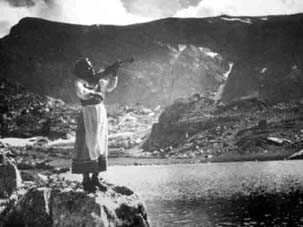 |
|
|
( From Reminiscences of the Master by Maria Zlateva, violinist who met the Master in 1921. ):
We used to learn the PanEuRhythmy outside in the meadow or in the Meeting Hall in small groups, each of
which would later have to demonstrate to others and help them learn.
Sometimes the morning lectures were very long and PanEuRhythmy lasted one hour, so people who were working
or studying had to leave the PanEuRhythmy circle early. Sometimes we couldn't dance because of the
weather or for some other reason. At such times the Master told us to cut out some of the
PanEuRhythmy exercises, and Simeon Simeonov ( one of the musicians ) would skip the First Day of Spring and start
from Evera.
One morning after PanEuRhythmy, when we had gathered round the Master to kiss his hand, he looked for
Simeon Simeonov, but he was busy. Then the Master turned to me and said, "Always play the first
three sections of the PanEuRhythmy: the First Day of Spring, Evera and Jumping. After that you can
skip alternate movements, playing odd numbers on one day and even numbers on the next. On weekends
and holidays, you can play the whole PanEuRhythmy without skipping any of the movements."
I asked the Master, "Would it be good to give a sign before each exercise for people to know which is the
next movement?"
The Master replid, "It is better without signs. Everyone needs to stay alert in order to know which
is the next movement. The musicians should take turns in playing and dancing and, when dancing,
should notice how the playing for the PanEuRhythmy could be improved."
At that time the orchestra was large and all who wanted could join in. The weaker musicians would
learn from the more advanced musicians. Two or three would play the second voice, usually Assen
Arnaoudov, Gabriel Velichkov, Stanka Yordanova, Philip Stoitchev and others. The music could be heard
from far away, and people passing through Izgrev would stop and listen. They would be impressed by the
music, and some of them later became disciples.
It is a mistake for musicians to want to play PanEuRhythmy alone. It is not important how beautifully
an individual musician can play, for PanEuRhythmy is a collective exercise, both for those dancing and for those
playing. Communal playing influences the soul in a very special way. When the Master was
alive, we used to play with many instruments and harmonize together, and we need to continue in that
way. Musicians can find opportunities for personal expression in concert halls.
We used to dance in a circle in a beautiful large sunny meadow with the Master dancing in the middle. We
aspired to dance as he danced and as he taught us. When we had learnt the dances, the Master asked Kiril
Ikonomov to take a metronome and measure the tempo while we were dancing. Sometimes when we were enjoying
ourselves so much that we neglected to focus sufficiently, the tempo speeded up or slowed down. Then when
we noticed the dancers, we saw our mistakes and corrected ourselves immediately. The PanEuRhythmy tempo
was determined by observing the steps of the dancers, and enabling them to dance rhythmically and gracefully.
Sometimes on the First Day of Spring it was very cold and we had to shovel away the snow. Then we
played under a shelter around a small fire.
We used the light from the fire under the shelter. Then I said to the Master, "How beautiful it would be
to have a grammophone!" and the Master answered, "No, it is better to have live music."
About the Pentagram, the Master told the musicians, "When you play the first beat, you need to stress it,
so that the upward stroke of the circular movement can be done more rhythmically. The same applies
in the Sunbeams. All dancers need to synchronize their arm movements."
It was about December 20th 1924, late one afternoon; Yarmila and I were walking in a meadow and
were happily surprised to see the Master coming slowly towards us wearing his long cloak. When he
reached us, he turned to Yarmila and said, "You, sister, will set and present the (PanEuRhythmy) exercises
in the right way."
Yarmila answered the Master, "I can't transmit them correctly, because I dance them as a ballet dancer, and that
is not how they were intended to be danced."
"No!" the Master interrupted, "You will consult those sisters who were close to me when I first
taught these exercises, such as Katya Griva and others."
"You will perfect the (PanEuRhythmy) exercises rightly," he repeated, and after those words he turned and walked away.
|
|
KROUM VAZHAROV: |
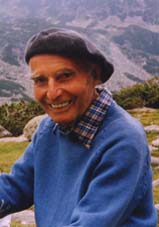 |
|
|
( Who came to the Master in 1927 and became one of his closest disciples, dictated the following to Maria
Mitovska. For 47 years after the Master's passing he worked among young people and foreigners
to ensure that the Master's teaching and the PanEuRhythmy would be faithfully transmitted. In order
to protect its essence and original spirit, Kroum organised the production of a film (now in DVD form),
"Peter Deunov's PanEuRhythmy, featuring PanEuRhythmy in Rila in 1977". ):
One day when Kroum was dancing PanEuRhythmy without a partner, the Master left his usual place in the middle
of the circle and came and danced with Kroum as his partner. As far as we know, this was the only time
the Master danced with any one else. This gave Kroum a great impulse, and Kroum understood from this
that the Master was empowering him for his later work with PanEuRhythmy.
Yarmila took very seriously what the Master had said about her responsibility for PanEuRhythmy and made this a
task for her life, producing at the end of her life in French a very carefully drawn up book, La
Paneurythmie: Le psychisme humain en Union avec l'Harmonie Universelle.
It was Kroum who first took Yarmila to Izgrev to introduce her to the Master as his fiancee. When the Master
asked the musicians to play the PanEuRhythmy music, Yarmila started dancing with the same movements as had been given
by the Master, even though she had never before experienced the PanEuRhythmy in any form. Then the Master
said, "See what correspondance there is between the music and the movements!"
|
|
"The life of the disciple must project into the future.
The world lives in the present. The future always undestands the raising of consciousness; the
past is a descending of consciousness from high to low; while the present is in transition.
The great future must permeate the present life of the disciple."
Beinsa Douno - # 412
|
|
|
Next Page
|
|
|
|